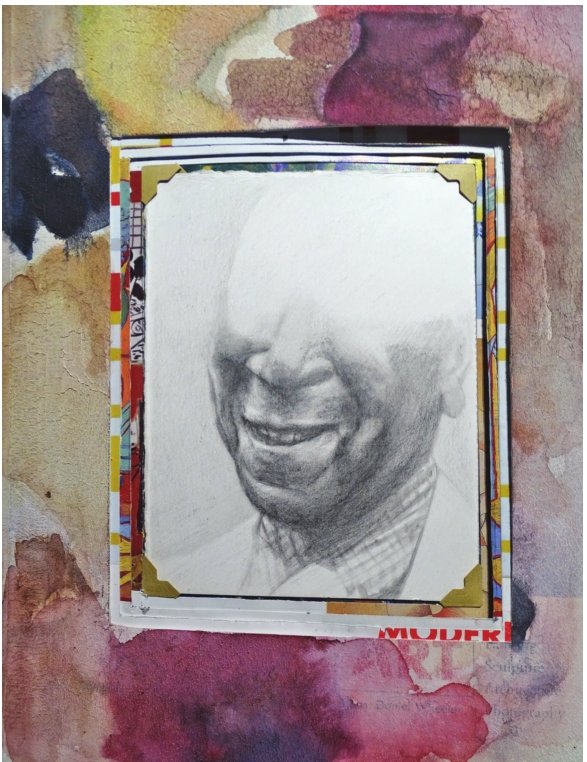Justin Bryant explores the blank spaces in African-American life

A smile is almost never just a smile. Justin Bryant’s delicate and disturbing solo exhibition at the LookOut Gallery at MSU’s Snyder Hall looks into some unsettling voids.
At the heart of the exhibit, viewable through Feb. 15, is an absorbing group of portraits of African- American life.
There’s a line-up of happy-looking kids, about to brush their teeth; a woman being carried off by police officers; a man protesting at a 1960s civil rights rally in Washington, D.C.; a group portrait of members of the Niagara Movement, an early civil rights group that met in Ontario, and several other scenes.
The wall of lithographs took Bryant months to finish.
Only he didn’t finish them. Most of the people in the portraits have no eyes.
Some of the portraits sit on small shelves, like family pictures.
“All these people — I’ve never met then and I don’t know them but they kind of feel like family to me,” he said.
Bryant, a native of Stuttgart, Arkansas, wrapped up a week-long residency at MSU’s Residential College in the Arts and Humanities last week.
One of the largest works in the exhibit is a portrait of author James Baldwin juxtaposed with a beautiful, starry sky. The top of Baldwin’s head is a pure white circle, withholding the mysteries of his keen eye and authorial brain from the viewer.
At a discussion hosted by poet Cindy Hunter Morgan Thursday, Bryant tied some of the ideas behind his work to a devastating poem by Maya Angelou, “The Mask.”
In “The Mask,” Angelou gives voice to a long-suffering laborer whose automatic laughter masks an abyss of hurt, and, by extension, unmasks a painful part of the black experience in America.
The bare patches in Bryant’s work have a multi-faceted relationship to the mask described by Angelou.
“It’s a power relationship,” Bryant said.
“It was my way of being careful — thinking about the people I was drawing, honoring them. It keeps the power on their side, what the smile could mean.”
Bryant uses several strategies to slip into the blank spaces of African-American life.
To create another piece in the “Minor Key” exhibit, he cut a hole in one of his art history textbooks and inserted a portrait of African-American artist Beauford Delaney, with the eyes missing.
When Bryant realized an important black artist was all but cut out of art history, he simply cut him back in — literally.
Delaney, a modernist painter associated with the Harlem Renaissance of the 1930s and 1940s, has inspired generations of artists.
Delaney’s friend James Baldwin called him “living proof, for me, that a black man could be an artist.”
Although Delaney’s work ranged from portraits and figurative work to a headlong plunge into Abstract Expressionism, he is still underappreciated and all but unknown to the broader public.
Bryant learned that many African- American artists emigrated or stayed in Paris in the middle of the 20th century, but are nearly forgotten now.
“I became really interested in how I didn’t know a lot of history that involved my own culture — and how I will never know it,” he said.
A striking series of paintings Bryant made a few years ago builds on the same idea in a different way.
He perched several notable buildings that were built by free or enslaved African- Americans on top of the heads of African- American people.
One of them is the White House, nestled in a lush Afro.
Bryant likened the buildings to “crowns.”
“They are painful images, but powerful,” he said.
One of the most ambitious works in the “Minor Key” exhibit is a set of four books, each one etched with a combined portrait of the Rev. Martin Luther King, Jr. and Bryant himself. Both faces change expression as you look from one end of the row of books to the other.
It’s a lot of visual information to take in, but Bryant is the first to admit he gets himself into some conceptual cul-de-sacs.
“I’m trying to get people to see that these ideas are multi-faceted, and that’s the hard part,” he said. “How do you talk about poetry, buildings, your own experience all together without it coming across as just a mess?” His impatience with the static, “finished” look of most gallery art is already evident in “Minor Key.” Next, Bryant plans to inject more narrative into his work — “figures in a scene, or something happening.” With a show coming up at the Thea Foundation in North Little Rock this fall, he’s girding himself for another gestation period and a few false starts.
He just got his master’s degree in fine art from Louisiana State University and he looks ready to cut a hole into it, at least figuratively. (Although, with Bryant, you never know.)
“In school, you’re often encouraged to make a lot of right decisions, but I think you’ve got to make a lot of wrong decisions first,” he said.
That, he said, pretty much describes the last five years of his life.
“I try to make mistakes daily,” he said.
“The crazy thing is that when you have enough confidence with it, it automatically is right.”
Justin Bryant “Lingering in the Minor Key” Through Feb. 15
LookOut Gallery MSU Residential College in the Arts and Humanities C200 Snyder Hall
Support City Pulse - Donate Today!
Comments
No comments on this item Please log in to comment by clicking here